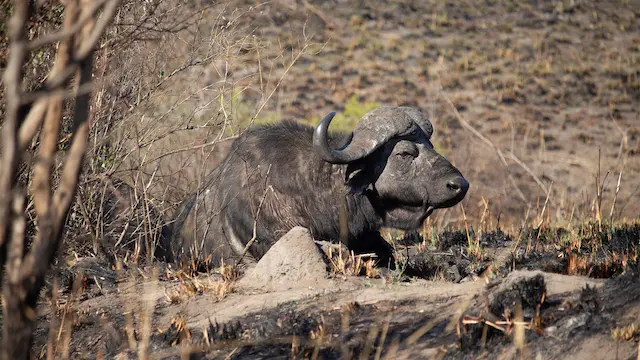African Buffalo in Kruger National Park
The African Buffalo (Syncerus caffer), also known as the Cape Buffalo, is one of the most formidable animals in Kruger National Park and a proud member of Africa’s iconic Big Five. Revered for its brute strength, unpredictable nature, and tightly knit herds, this impressive grazer plays a vital role in the park’s ecosystem. Whether you’re a seasoned safari-goer or a first-time visitor, spotting a buffalo in the wild is an unforgettable part of your Kruger experience.
Where to See Buffalo in Kruger
African buffalo are widespread across Kruger National Park, from the lush riverine woodlands of the south to the open mopaneveld of the north. They require water daily, making them easy to locate near rivers, waterholes, and seasonal pans.
- Lower Sabie & Skukuza Area: Along the Sabie River and roads like the H4-1 and H4-2, herds are often seen drinking or resting near the banks.
- Satara Region: The H7, S100, and N’wanetsi areas offer frequent sightings of large herds.
- Olifants & Letaba: This central region has consistent sightings, especially near the Olifants River.
- Mopani & Shingwedzi: Buffalo still roam these drier regions in smaller groups, often along the rivers.
Buffalo Herds in Kruger
Buffalo in Kruger can be seen in a variety of groupings, from solitary bulls to mega-herds numbering in the hundreds.
- Breeding Herds: Large mixed groups with cows, calves, and young bulls that roam widely in search of grazing and water.
- Bachelor Herds: Older males often form smaller groups or remain solitary. These “dagga boys” are known for wallowing in mud and their short temper.
Fun fact: Buffalo herds are highly protective. If a lion tries to attack a calf, the entire herd may come to its defense — a powerful example of unity in the wild.
Buffalo Behavior in Kruger
- Protective Defense: When threatened, buffalo form a defensive circle with calves in the middle and horns facing outward.
- Memory and Awareness: Buffalo remember water sources and danger zones, making strategic movements across the park.
- Unpredictable Nature: Despite being herbivores, buffalo are known to charge when provoked or injured, making them highly dangerous on foot.
Kruger Buffalo Sightings: What to Expect
- Sunrise and Sunset: Prime times for spotting herds moving to or from waterholes and grazing grounds.
- Dry Season: As water becomes scarce, herds gather in predictable spots for easier viewing.
- Predator Interactions: Watching lions stalk a herd can offer some of the most intense safari moments.
Best Time to See Buffalo in Kruger National Park
Dry Season (May to October):
- Best visibility as vegetation thins out.
- Waterholes become crucial gathering points for large herds.
Wet Season (November to April):
- Lush greenery may obscure sightings, but buffalo remain abundant.
- Calving season offers a chance to see young buffalo — and predators on the move.
Related Internal Links for More Wildlife Insight
External Sources for More Information
Safari Tips for Buffalo Spotting
- Look for dust clouds — large herds often kick up dust while moving.
- Scan rivers and waterholes, especially early morning or late afternoon.
- Listen for oxpeckers — their calls can lead you to nearby buffalo.
- Stay in your vehicle — solitary bulls can be extremely dangerous on foot.
Conclusion
The African buffalo is not just another antelope — it’s a keystone species with immense strength, a tight social structure, and an essential role in Kruger’s biodiversity. Whether you witness a massive herd crossing a dusty road or a lone bull wallowing in mud, each encounter is a testament to Africa’s wild spirit. Understanding their habits, behaviors, and environments will elevate your safari experience and deepen your appreciation for these incredible animals.

